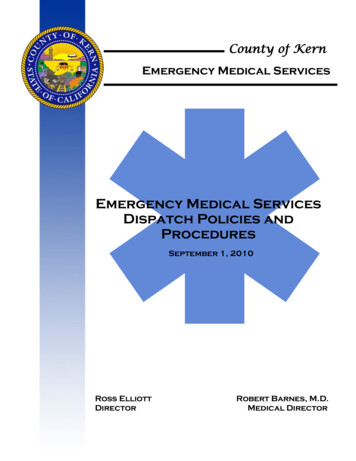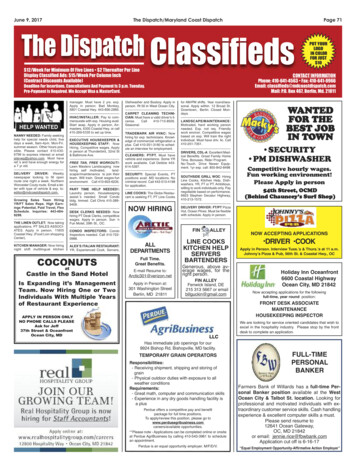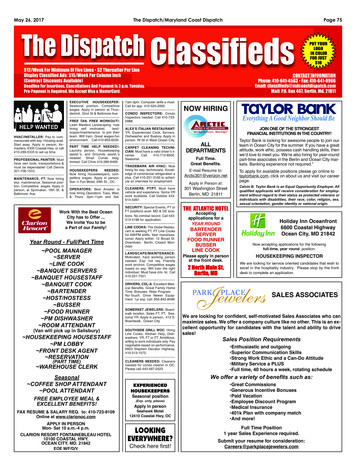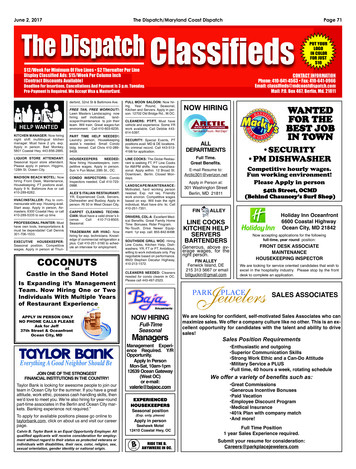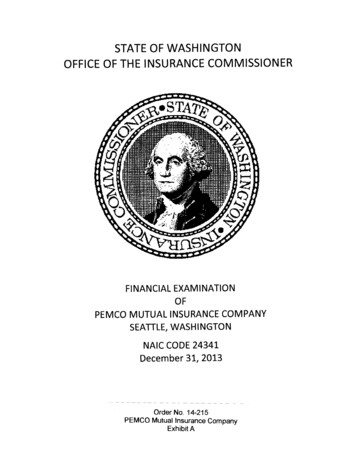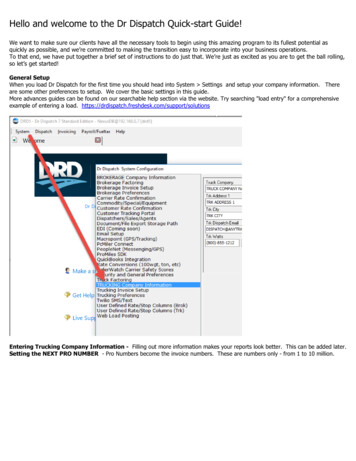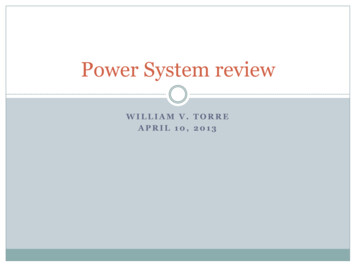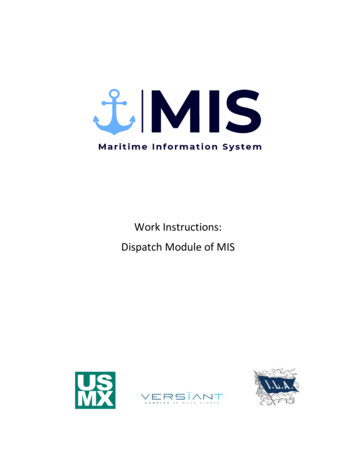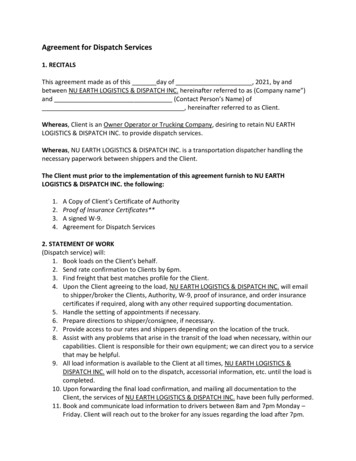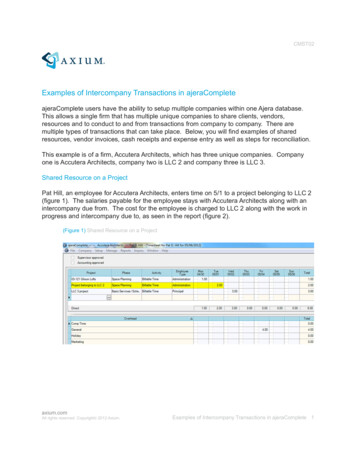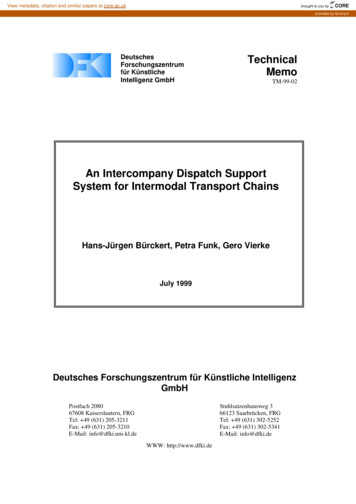
Transcription
View metadata, citation and similar papers at core.ac.ukbrought to you byCOREprovided by AcronymDeutschesForschungszentrumfür KünstlicheIntelligenz GmbHTechnicalMemoTM-99-02An Intercompany Dispatch SupportSystem for Intermodal Transport ChainsHans-Jürgen Bürckert, Petra Funk, Gero VierkeJuly 1999Deutsches Forschungszentrum für Künstliche IntelligenzGmbHPostfach 208067608 Kaiserslautern, FRGTel: 49 (631) 205-3211Fax: 49 (631) 205-3210E-Mail: info@dfki.uni-kl.deStuhlsatzenhausweg 366123 Saarbrücken, FRGTel: 49 (631) 302-5252Fax: 49 (631) 302-5341E-Mail: info@dfki.deWWW: http://www.dfki.de
Deutsches Forschungszentrum für Künstliche IntelligenzDFKI GmbHGerman Research Centre for Artificial IntelligenceFounded in 1988, DFKI today is one of the largest non-profit contract research institutes in the field ofinnovative software technology based on Artificial Intelligence (AI) methods. DFKI is focusing on thecomplete cycle of innovation — from world-class basic research and technology development throughleading-edge demonstrators and prototypes to product functions and commercialisation.Based in Kaiserslautern and Saarbrücken, the German Research Centre for Artificial Intelligenceranks among the important "Centres of Excellence'' world-wide.An important element of DFKI's mission is to move innovations as quickly as possible from the lab intothe marketplace. Only by maintaining research projects at the forefront of science can DFKI have thestrength to meet its technology transfer goals.DFKI has about 115 full-time employees, including 95 research scientists with advanced degrees.There are also around 120 part-time research assistants.Revenues for DFKI were about 28 million DM in 1998, half from government contract work and halffrom commercial clients. The annual increase in contracts from commercial clients was greater than37% during the last three years.At DFKI, all work is organised in the form of clearly focused research or development projects withplanned deliverables, various milestones, and a duration from several months up to three years.DFKI benefits from interaction with the faculty of the Universities of Saarbrücken and Kaiserslauternand in turn provides opportunities for research and Ph.D. thesis supervision to students from theseuniversities, which have an outstanding reputation in Computer Science.The key directors of DFKI are Prof. Wolfgang Wahlster (CEO) and Dr. Walter Olthoff (CFO).DFKI's six research departments are directed by internationally recognised research scientists: Information Management and Document Analysis (Director: Prof. A. Dengel) Intelligent Visualisation and Simulation Systems (Director: Prof. H. Hagen) Deduction and Multiagent Systems (Director: Prof. J. Siekmann) Programming Systems (Director: Prof. G. Smolka) Language Technology (Director: Prof. H. Uszkoreit) Intelligent User Interfaces (Director: Prof. W. Wahlster)In this series, DFKI publishes research reports, technical memos, documents (e.g. workshopproceedings), and final project reports. The aim is to make new results, ideas, and software availableas quickly as possible.Prof. Wolfgang WahlsterDirector
An Intercompany Dispatch Support System for Intermodal TransportChainsHans-Jürgen Bürckert, Petra Funk, Gero VierkeDFKI-TM-99-02
The work reported in this paper is funded by the INTERREG II programmeSaarland/Lothringen/Pfalz, the Transport RTD Programme of the EuropeanCommission, Platform project PL 97-2170, as well as by Telecommunication InitiativeSaar of the Saarland Government. Deutsches Forschungszentrum für Künstliche Intelligenz 1999This work may not be copied or reproduced in whole or part for any commercial purpose. Permission to copy inwhole or part without payment of fee is granted for non-profit educational and research purposes provided that allsuch whole or partial copies include the following: a notice that such copying is by permission of the DeutscheForschungszentrum für Künstliche Intelligenz, Kaiserslautern, Federal Republic of Germany; anacknowledgement of the authors and individual contributors to the work; all applicable portions of this copyrightnotice. Copying, reproducing, or republishing for any other purpose shall require a licence with payment of fee toDeutsches Forschungszentrum für Künstliche Intelligenz.ISSN 0946-0071
An Intercompany Dispatch Support System for IntermodalTransport ChainsHans-Jürgen Bürckert, Petra Funk, Gero VierkeGerman Research Center for Artificial Intelligence, DFKI SaarbrückenStuhlsatzenhausweg 3, D-66123 Saarbrücken, Germany; {hjb, funk, vierke}@dfki.deAbstract: A critical problem in an intermodal transport chain is the direct meet at the transhipment nodes. Thisrequires information technology and modern communication facilities as well as much closer collaborationbetween all the concerned transport operators in the chain. The TELETRUCK system – currently underdevelopment at the German Research Center for Artificial Intelligence (Deutsches Forschungszentrum fürKünstliche Intelligenz DFKI GmbH) – is a dispatch support system that tackles those problems. Intercompanyplanning, scheduling, and monitoring of intermodal transport chains will be supported by our system. It aims atproviding smooth access to railway time tables and rail-based transport services and – much more important – atallowing for the planning of both, exclusively road-based and combined journeys and showing their costeffectiveness, where- and whenever possible. We will describe our approach – based on intelligent agenttechnology – both the current state of implementation and our goal of the very next future.1IntroductionFreight transport in Europe has immensely grown during the last decade and is expected to increase even more inthe next future. Due to the drawbacks of purely road-based transport, such as congestion, environmentalproblems, traffic noise and social impact, intermodal transport plays an important role in the economic and socialdevelopment of the European countries:"The growing demand for the transport of people and goods in Europe presents transport users, operators andpublic authorities with increasing problems, notably concerning cost-effectiveness, congestion andenvironmental impact. Whereas, in the past, we have tended to think about specific modes of transport – road,rail, air and waterborne – there is now growing recognition that sustainable mobility is about inter-connectingtransport systems which have to provide a door-to-door service. This is what I call intermodality. "[Kinnock 95]The development of information and communication technology (ICT) supporting planning, optimisation, andmonitoring of freight haulage for terminals as well as for all other service providers of intermodal transportchains is one of the most challenging application domains for computer and business sciences in thetransportation sector. The integration of the Trans-European Networks (TEN) of transports andtelecommunications, comprising equipment of transport vehicles, departments and companies withtelecommunication facilities linked with assistance software for logistics engineers and dispatch officers as wellas drivers and transport operators, is a main goal of the next decade. It will provide the fundamental buildinggrounds for keeping the growing Trans-European transport demand controllable and manageable: Outsourcing,depot free production, just in time delivery will still increase transport intensity. Freight transport within theEuropean Union is expected to grow by another 70% during the next ten years [Carroué97].The European Commission (EC) had recognised that dramatic development and intermodality got a growinginterest within European transport politics: The EC Task Force on Transport Intermodality elaboratedrecommendations for the future development of intermodal transport (Intermodal Freight Village 2000 ,Intermodal Freight Network 2000 , Transport Town 2000 , etc.) and several actions are addressing differentaspects of improving and supporting intermodal transport chains [TaskForce 97].Most of the European transport companies are small or medium sized enterprises widely focussing on roadtransportation. They are working in a highly competitive framework still sharpened by the low cost competitorsfrom Eastern Europe. Rail transportation is yet much to inefficient, in order to be competitive, at least fordistances below 700 km. Combined rail-road transportation can become a much more interesting alternative inthe near future. However, this requires software products which support dispatch officers in their daily work byproviding smooth access to railway time tables and rail-based transport services and – much more important – byallowing for the planning of both, exclusively road-based and combined journeys and showing their costeffectiveness, where- and whenever possible.Intermodal freight transport makes high demands on planning, scheduling, and monitoring: Selection of the bestsuited mode for every subtour in a transport chain, determination of an optimal sequence of the different modes,scheduling just-in-time meets of the means of transport in the chain, in order to avoid unnecessary delays fortranshipment, and of course, optimal planning of the single subtours as well as monitoring of plan execution.GPS and board communication systems at trucks, satellite-based tracking and tracing facilities for containers,computer-based dispatch support and information systems at all transport service providers in the chain must tobe connected for direct communication between these systems, in order to allow an elaborated organisation andmanagement of intermodal transport chains.1
At the German Research Center for Artificial Intelligence (DFKI) we currently develop the TELETRUCK systemfor supporting collaborating transport operators in planning, scheduling, and monitoring of intermodal transportchains. This task is conducted in close collaboration with forwarders, terminal operators, and transport engineers.In the next section we will describe the problem of intermodal transport planning. It is followed by anintroduction of the multi-agent technology and the procedures we are using for the solution of that planning andoptimisation problem. The architecture of our current implementation and an outlook of further extensionsconcludes the paper.2Intermodal Transport ProblemsIn general we can define an intermodal transport as any kind of transport, which combines at least two differenttransport modes and thus a transhipment process between these two. Examples are the combination of road andrail, or the combination of road and waterborne. Usually the pre-carriage or onward carriage is carried out byroad, while the main carriage may be done by the other means of transport, namely train, ship or plane. But otherand more complex combinations are also possible.Origin7 7 DestinationFigure 1: The Intermodal Transport ChainWe focus on the special instance, the combined road–rail transport, but any other combination of modes can alsobe teckeled with our approach. In our case, we have road based pre- and end haulage, while the main carriage isdone by rail. Currently rail-based transport imposes the main constraint on the processing of an intermodaltransport: It is a time-tabled mode which does not offer much flexibility in terms of pick-up or delivery times ofthe goods to be transported. These goods, filled in Intermodal Transport Units (ITU – it can be any kind ofcontainer, semi-trailer or other transport bin), need to be at the intermodal terminal connecting road and rail, inorder to be transhipped in time. Thus, the road based carriages of the intermodal transport have to provide theflexibility required to process the intermodal transport as a whole, such that – at the intermodal terminals – weget an optimal meet of the two involved means of transport, trucks and trains (cf. Figure 1).2.1Planning Orders for Intermodal Transport ChainsThe most crucial process connected with intermodal transports is the transition from one transport mode to thenext. While on the physical side many efforts to enhance transhipment procedures are undertaken, e.g. in the EUProjects IMPULSE and COREM, smooth transition procedures and policies on the software side are yet to bedesigned. Planned arrivals of trucks in a terminal can help to deal with the usual congestion at gate opening andit can support the use of terminal resources in terms of people or equipment during otherwise idle times.Scheduling of delivery (or pick-up) just in time, ie., planning the arrival of trucks, such that a direct meetbetween the train and trucks is possible, will avoid storage times and thus reduce transportation times – andhence transportation costs – substantially. This can make intermodal transports competitive – also for mediumdistance haulage.The planning of intermodal transport orders to be processed within an intermodal transport chain, requires toadapt the planning process to the individual characteristics of each transport mode. Modern, paralleltranshipment technology, which allows for simultaneous transhipment of ITUs between several waggons andtrucks, as well as new ways of time-tabled freight trains with high frequent connections between big freightterminals – similar as for todays passenger transport – and booking and reservation procedures for traincapacities have to be supported by modern information and communication technology. Road based feedertransport has to planned and optimised dynamically, such that just in time arrival of trucks is possible. Moderntelematics technology allows for a planning process that takes into account the current status and positions of thetrucks. AI technology can be used for a flexible online planning and optimisation procedure based on intelligentagents.2.2Intercompany Planning of Transport ChainsIn the highly competitive transportation domain optimisation of transport planning is a crucial issue. Theoptimisation potential of a transportation company corresponds to the amount of freight that has to betransported. Therefore, small and medium sized enterprises are at a disadvantage. One approach to overcome2
these difficulties is to form unions of small and medium sized enterprises in order to optimise transport planningcooperatively.The main challenge of this approach is to establish a long-term cooperation among competing companies. Ingeneral a company is self-interested and tries to optimise its local profit. These local goals conflict with theglobal optimisation. In order to achieve global optimisation, incentive mechanisms that transfer the global utilityto local utility need to be applied.Negotiation techniques based on market like mechanisms (simulated auction and simulated trading protocols)using intelligent agent technology and telecommunication connections for the partner companies’ planningsystems can support such forms of cooperation.3Holonic Multi-Agent TechnologyAs mentioned above intelligent agents can be used in order to realise a highly flexible, online planning andoptimisation procedure for intermodal and intercompany transport planning. Our TELETRUCK system is a multiagent system (MAS) [OHare 96]: We model the basic objects and processes of our transportation planningdomain as autonomous, continuous software processes which are re-activ (they observe and influence their real or virtual environment;) pro-activ (they execute actions in a forward planning and goal-directed manner;) inter-activ (they communicate, negotiate, and cooperate with other agents.)Therefore, these agents are equipped with planning skills, knowledge about the individual resources of theobjects they represent, negotiation and communication facilities for interaction and cooperation among eachother. The transport domain is rich in tasks requiring coordinated and cooperative actions, which can besmoothly solved by such a decentral approach. Dividing the transport request according to intermodal orintercompany requirements can be done by the planning agents in our agent society.Our agent society is organised as a holonic MAS [Gerber 99]. That means agents can unfiy into a holonic agentor a holon1 and partially loose their autonomy, in order to collaborate, e.g., for resource sharing. For planningand execution of cooperative tasks, single agents melt together to a new, holonic entity, tackling the task andseparating afterwards.IPnEUIPnEUInitial ervice AgentBrokerFinal LegOrderMain LegOrder Main LegPlan Set [.]oxoxox.14ox20ox0.1o22ox.05ox23oxx0o0.1Final LegPlanInitial tworkNetworkAreaAreaRoadService AgentBrokerBrokerRail Service AgentFigure 2: IPnEUs, Road and Rail Service Agents3.1The TELETRUCK Agent SocietyFrom a technical point of view, our MAS is distributed on several computers located at the different transportservice operators in the intermodal transport network. Each of the local systems is a copy of our TELETRUCKsystem, which can be used both as a stand-alone planning and scheduling system for the local service providerand as a cooperative planning and scheduling system which interacts with the systems of the partners. That1Derived from holos [Greek] which means the whole and the Greek suffix -on denoting parts or particles.3
means the whole TELETRUCK network2 is a distributed MAS that cooperatively plans intermodal transportchains. Orders are splitted or combined, distributed and exchanged among the connected systems.The local TELETRUCK systems in turn are organised as multi-agent systems. Each of them is headed by acompany agent, representing the whole system to the partners’ systems (i.e. their company agents) in the networkand coordinating further internal agents of the local system.Customers send their transport order to any of these local service providers. Special internal agents calledIPnEUs (intermodal plan’n’execute units) of the local systems take the responsibility for planning and executionof the tasks by intermodal transport chains (cf. Figure 2). For each order, an IPnEU is invoked, which managesall the planning and scheduling activities required. The IPnEUs split the transport of an order into an initial,main, and final leg (or even further sub-journeys) to be executed in different modes. They announce subtasks tocorresponding partners in the network: train booking and reservation departments at terminals, who know about the trains’ time tables and freecapacities, and are responsible for train booking and reservation; the road forwarders or logistics service centers in the regions around the source and destination terminals ofthe rail based main leg, respectively, who coordinate the initial and the final leg of the intermodal transportchain in the regions.The local systems of the train booking and reservation departments are realised as intelligent rail service agentsin our multi-agent network – one might think of it as reduced TELETRUCK system without any other agents thanthe company agent. The local systems of the logistics service centers are again implemented as reducedTELETRUCK systems with a company agent, called road service agent, and with instances of IPnEUs but withoutfurther internal agents. The road service agents just know about road forwarders which collaborate with thelogistics service centers and which are staffed by complete TELETRUCK systems. The road service agents contactthe company agents, called dispatch agents, of the forwarders' local systems for execution of the road based localtransport (cf. Figure e AgentBrokerForwarder ADispatch AgentForwarder BDispatch AgentELEELETransport AgentsForwarder CDispatch AgentRUCKRUCKTransport AgentsTransport AgentsFigure 3: Road Service, Dispatch, and Transport AgentsIn addition to dispatch agents and the instances of IPnEUs in our complete TELETRUCK systems also the physicaltransport means of each transport service operator are internally represented as agents, thus physical transportunits like trucks, trains, ships etc. are modelled by agents, too.3 Via GPS and board communication systemsthese transport agents know status and position of the physical objects they represent. Based on that informationthey can accept or reject transport orders announced by the dispatch agent and plan their tours. They can alsoexchange orders with other transport agents within the local agent society. Exchange of orders with partnersystems, however, is only possible on the dispatch agents' level.2In the following we will refer to the local systems as TELETRUCK systems and to the whole network ofTELETRUCK systems as TELETRUCK network3Currently train agents are not implemented, instead we manage their transport resources by a a bookingprocedure realised by a contraint solver for time and capacity constraints.4
uckTrailerDriverDriverFigure 4: Dispatch Agent and Transport Holons with Component AgentsThe transport agents are the holons of our approach (cf. Figure 4). They are composed of subagents which yieldsin a very flexible planning and execution procedure. The transport units of a road carrier, for example, consist ofthe physical components: motor components (truck or truck tractor), chassis components (trailer or semi-trailer),load spaces (container or swap-body), and drivers. Each component including the driver is represented by anagent as well. These component agents dispose of their local resources for the planning task and they interactwith the other component agents in order to achieve self-organised compositions of the whole transport unitsaccording to the transport needs. To enhance the cooperation between these subagents we introduce a road-basedplanning and execution agent, the PnEU (plan’n’execute unit), which plays the role of a head of a transportholon. Thus it organises the holonic structure during planning and execution of the road-based transport partsand represents the transport holon to the other agents in the TELETRUCK system.This holonic multi-agent system approach allows for a very flexible organisation of transport planning.Communication and negotiation of the agents are driven by auction and trading protocols (cf. Figure 5): Agentsof the upper level act as brokers for the agents of the next level announcing the tasks (or subtasks). The loweragents bid for the tasks on the basis of their free capacities. This auction mechanism is realised through acontract net protocol. In order to optimise the plans tasks are exchanged between agents organised by asimulated trading protocol: The agents ask for buying or selling tasks in order to optimise their plans. The brokerof the upper level coordinates this in choosing "best matches" of buy and sell requests, in order to improve alsothe global plan of that level. These market-oriented mechanisms are realised on all levels in order to obtainglobally optimised intermodal transport plans assuming the overall system can run long enough.5
LogististicsService CenterSimulatedAuctionForwarder ASimulatedTradingForwarder TradingTransportAgentFigure 5: The Holonic Agent Hierarchy of the TELETRUCK NetworkThe optimisation process is realised as an anytime algorithm. Thus it can be interrupted any time yielding a suboptimal but feasible plan. Since the two protocols are interleaved, new orders can be announced during theoptimisation process. The resulting procedure therefore allows for dynamic planning as well as for re-planning incase of dynamic changes of orders. Also online planning and optimisation is possible, because – as mentionedabove – the agents know about status and position of the physical objects they represent. Hence they are able toplan, re-plan, and optimise plans also during plan execution – for those parts of the plans not yet finished.3.2Contract Net Protocol – An Auction Mechanism for Order Distribution andMobilisation SchedulingFor the distribution of goods onto means of transport, we apply an extension of the contract net protocol, apopular DAI allocation mechanism. In its original version [Smith 80] this protocol is rather simple: A managerannounces a task to a set of contractors. Based on their local cost estimations, these contractors compute bids andsend them to the manager. The manager selects the best bid, rejects all other bids, and grants the task to the bestbidder. This contractor is committed to report the success or failure of the task’s execution to the manager.In the TELETRUCK system the company agent plays the role of the manager who distributes transportation tasksto the contractors, the PnEUs. Those PnEUs that head a transport holon have all the needed resources at theirdisposal to plan the tasks. The idle PnEU composes a fresh transport holon from the idle components. This isdone in a decentral manner: The PnEU announces the task to the motor agent, the motor agent announces it tothe driver agent and the chassis agent, the chassis agent announces it to the load space agent (see Figure 6).These cascading contract nets allow for local compatibility checks between the resources [Bürckert 98].Usually the tasks announced in a contract net are treated as indivisible. Since large orders may exceed thecapacity of one truck, they have to be split into subtasks of smaller amount in order to distribute them to morethan one truck. In the intermodal case, the transport requests to be executed by several means of transport, has tobe split into subtasks covering different parts of the total distance. Hence, a more flexible extension of thetraditional protocol is required.6
dgeacknowledgeFigure 6: The Interaction Diagram of Internal Agents of a TELETRUCK SystemThe extended contract net protocol as described in [Fischer 96] allows to split a task into subtasks of feweramount and to distribute these subtasks to several contractors. Like in the original version of the contract net, themanager announces the task to the contractors. The contractors may not only place bids for the complete task,but may also bid for parts of the task. The manager selects the best of the bids, and grants it temporarily, i.e. themanager has the possibility to withdraw the grant. Then the manager rejects the other bids and subtracts thetemporarily granted subtask from the complete task. The remaining part is announced iteratively. When bids forall the subtasks are present and temporarily granted, the manager sends definitive grants to the involvedcontractors and confirms the distribution. If the manager fails to allocate all subtasks to the contractors thetemporal grants are withdrawn and the task cannot be planned.The splitting of tasks’ routes, in order to bundle smaller tasks that are to be transported over long distance onlarger trucks or by train, requires more than one parameter to split. There may be many possibilities to plan thetasks using different modes of transport and different intermediate locations for the exchange of modes.Furthermore, the time constraints of the subtasks are naturally connected.In our intermodal scenario, the intermodal planning agent IPnEU chooses the shortest intermodal route, andsplits the task into three subtasks: the rail based main-run and the road based pre- and end-run. Firstly, for themain-run the rail service agent is requested for a reservation on a train. The reservation is temporarily granted,the time constraints are propagated to the pre- and end-run, and the pre- and end-run are announced to the roadservice agents which in turn start a contract net with the dispatch agents. When there are reasonable bids for allsubtasks, they are definitively granted.Our envisioned system goes even further. Since different modes of transportation are to be evaluated, differentpossible routes have to be checked. In the integrated system the IPnEU will select at minimum two possiblepartitions for the task: One or more purely road-based routes and one or more, road-rail combinations. Thenseveral extended contract nets as in the intermodal case are triggered in parallel. The set of bidders that providesthe best transportation chain is finally granted the task.In the intermodal as well as in the integrated scenario, the extended contract net protocol is used for agentcommunication. Nevertheless, the allocation mechanism behind the protocol goes beyond the approach of[Fischer 96]: in our system the intelligent partitioning of tasks into subtasks is done by the manager based onglobal knowledge.3.3Simulated Trading Protocol – A Market-Mechanism for Plan OptimisationThe contract net protocol, as it has been described above, is used to achieve an initial, usually suboptimalsolution. In order to improve that plan, we apply a heuristic optimisation procedure called simulated trading[Bachem 92]. Suboptimal initial solutions are improved stepwise towards globally optimal plans by anextension of that distributed optimisation approach [Fischer 96].7
Simulated trading is a randomised algorithm that realises a market mechanism: the transport holons optimisetheir plans by successively selling and buying tasks. Trading is done in several rounds. Each round consists of anumber of decision cycles. In each cycle the transport agents submit one offer to sell or buy a task. At the end ofeach round the dispatch agent tries to match the sell and buy offers of the trucks such that the costs of the globalsolution decrease. This implements a kind of hill-climbing algorithm. Like in simulated annealing a derivationthat decreases from round to round can be specified such that in early ro
An Intercompany Dispatch Support System for Intermodal Transport Chains Hans-Jürgen Bürckert, Petra Funk, Gero Vierke July 1999 . telecommunication facilities linked with assistance software for logistics engineers and dispatch officers as well as drivers and transport operators, is a main goal of the next decade. It will provide the .
